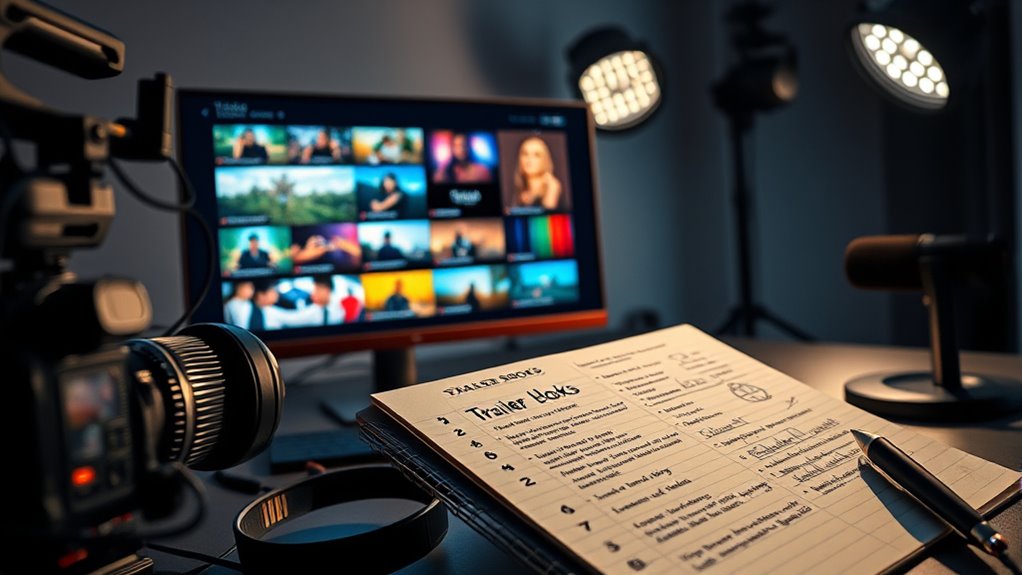To craft a trailer script that hooks viewers, start by identifying what your audience cares about and tailor your message to excite or intrigue them immediately. Open with a bold statement or provocative question and use striking visuals and sounds to grab attention. Keep the pacing quick and focused, highlighting the core conflict or unique selling point, then build suspense leading to a clear call to action. The secrets to making your trailer unforgettable are right here — explore further to master the art.
Key Takeaways
- Start with a bold opening line or provocative question to immediately capture interest.
- Highlight the main conflict or high stakes to create emotional investment.
- Use striking visuals and sound cues to build tension and intrigue from the outset.
- Keep the script concise by focusing on key moments and avoiding unnecessary details.
- End with a clear call to action that motivates viewers to engage or learn more.
Understand Your Audience and Purpose

Have you ever wondered why some trailers instantly grab your attention while others fall flat? It all starts with understanding your audience demographics and clarifying your purpose. Knowing who you’re targeting helps you tailor your message, tone, and visuals to resonate with viewers. Are you appealing to teenagers or adults? Fans of action or comedy? Clarifying your purpose guides your choices, ensuring every scene and line serves a specific goal—whether to excite, inform, or intrigue. When you identify your audience’s preferences and needs, you create a trailer that speaks directly to them. This focus makes your trailer more compelling, increasing the chances it’ll stick in viewers’ minds and spark their curiosity to watch the full content. Using audience analysis techniques can further refine your messaging for maximum impact, and understanding content targeting strategies can help you craft a more effective trailer.
Start With a Strong Opening Line

A captivating opening line sets the tone and instantly grabs your audience’s attention. It’s your chance to evoke emotion through visual storytelling techniques and make viewers eager to learn more. These techniques create an immediate emotional appeal, making viewers feel connected and invested from the start. To do this effectively: 1. Use a bold statement or provocative question that sparks curiosity. 2. Introduce a powerful image or scene that promises an emotional payoff. 3. Pose a relatable dilemma or challenge that resonates deeply with your audience. Incorporating emotional connection techniques can enhance engagement and ensure your message resonates on a personal level. Additionally, understanding the importance of sustainable messaging can help craft an opening that aligns with your broader story. Recognizing the significance of audience engagement strategies can further strengthen your hook. For example, a call to action or an intriguing mystery can immediately draw viewers in and foster a sense of personal relevance. Your opening line should set the mood and hint at the story’s core without giving everything away. The goal is to hook viewers instantly and compel them to keep watching.
Highlight the Core Conflict or Unique Selling Point

To make your trailer compelling, you need to clearly emphasize the main issue or conflict that drives the story. Highlight what makes your project unique to grab attention and stand out. Also, convey the high stakes involved to hook viewers and create a sense of urgency. Incorporating elements like generative AI in storytelling can add a futuristic or innovative appeal that captivates audiences and emphasizes your project’s relevance in today’s evolving media landscape. Additionally, showcasing how emerging cryptocurrency trends influence the narrative can underscore the story’s timeliness and importance in the rapidly changing digital environment. Considering regional variations in bank hours can also demonstrate a modern, globally aware setting that resonates with diverse viewers. Recognizing the spiritual significance of numbers, such as the number 7, can subtly enrich the story with deeper symbolic meaning, engaging viewers on a spiritual level.
Emphasize the Main Issue
Why is highlighting the main issue essential in a trailer script? Because it instantly conveys the core conflict or unique selling point that hooks viewers. When you clearly emphasize this, you make the audience feel the stakes and emotional pull. Consider genre considerations—show what makes your story compelling within its category. Budget constraints also shape how you showcase the main issue; focus on impactful visuals and concise storytelling. To evoke emotion, highlight:
- The protagonist’s urgent dilemma that resonates emotionally
- The stakes that threaten everything they care about
- The unique twist or conflict that sets your story apart
- Incorporating goal tracking techniques can help you stay focused on the core message and refine your trailer’s main issue over time. Additionally, understanding gaslighting tactics and how they impact emotional stability can deepen the audience’s connection to the story’s conflict. Recognizing how environmental considerations influence narrative themes can also add depth to your storytelling. Moreover, analyzing zodiac sign compatibility and other relationship dynamics can inspire character interactions that highlight emotional stakes and personal conflicts. Employing security features as seen in payment processing solutions can also serve as a metaphor for safeguarding what matters most in your story.
Showcase Unique Features
What makes your story stand out from the rest? Highlight its unique features by emphasizing the core conflict or selling point. Use striking special effects to catch viewers’ attention and create visual intrigue. Showcase how your characters develop uniquely, revealing their motivations and growth in moments that excite curiosity. Focus on what sets your story apart—whether it’s a groundbreaking concept, a twist, or a compelling message. Incorporate clips that demonstrate these features, giving viewers a taste of what’s to come. By clearly showcasing your story’s core conflict or unique selling point, you hook audiences early, making them *keen* to see more. Remember, a trailer that emphasizes what’s special about your story will resonate and leave a lasting impression. Additionally, incorporating visual storytelling techniques can further enhance engagement and curiosity, especially when understanding art theory and how it influences the presentation of your narrative. Utilizing engaging imagery can also amplify the impact of your trailer, making it more memorable and compelling, and understanding dream symbolism can inspire creative ways to evoke emotions and intrigue your audience. Exploring content creation strategies can help you craft a trailer that effectively highlights your story’s uniqueness and captivates viewers from the start.
Convey High Stakes
Highlighting what’s at stake in your story captures viewers’ attention and sparks their curiosity. To do this effectively, you need to convey high stakes through a clear core conflict or unique selling point. This involves a precise risk assessment—what’s truly at risk if your story’s protagonist fails? Focus on the emotional impact to deepen viewer engagement. For example: 1. Show the devastating consequences if they fail, evoking fear or empathy. 2. Highlight the urgency, making viewers feel the pressure to see the outcome. 3. Emphasize the personal or universal stakes to deepen emotional resonance. Additionally, understanding the security features of your story’s elements can help create more compelling and relatable stakes for your audience.
Use Visual and Auditory Hooks Effectively

Have you ever noticed how some trailers grab your attention instantly through striking visuals or enthralling sounds? That’s the power of effective visual and auditory hooks. Use visual symbolism to create instant recognition or emotion—like a broken clock to symbolize urgency or a flickering light for danger. Pair this with smart sound design: a sudden crescendo, a whisper, or a heartbeat can heighten tension and draw viewers in. Keep your visuals bold yet meaningful, avoiding clutter, and craft sounds that complement the mood without overwhelming the message. When you combine compelling visuals with targeted sound design, you create an immersive experience that hooks viewers from the first second, making them enthusiastic to see the full story.
Maintain Pacing and Build Suspense

To keep viewers engaged, it is crucial to control the pacing throughout your trailer. Use visual pacing to quicken or slow scenes, guiding emotional responses. Incorporate suspense techniques like sudden cuts, lingering shots, and strategic silence to heighten tension. Focus on these key elements:
Controlling pacing with quick cuts, silence, and scene variation keeps viewers engaged and heightens suspense.
- Vary scene lengths to create rhythm and anticipation
- Build up to a climax with escalating visuals and sound
- Use pauses and silence to amplify suspense and keep viewers on edge
Keep the Script Concise and Focused

To keep your trailer script sharp, focus on trimming unnecessary details that don’t serve your main message. Highlight the key moments that will grab attention and spark curiosity. Staying concise guarantees your trailer remains impactful and leaves viewers enthusiastic to learn more.
Trim Unnecessary Details
Since a trailer script is meant to quickly grab attention, every word must count. Trim unnecessary details to keep your message sharp and impactful. Focus on what truly evokes emotion and supports your core message. To do this, consider these steps:
- Prioritize dialogue realism—use natural, relatable language that resonates instantly.
- Ensure visual consistency—align visuals with the tone to create a seamless experience.
- Remove any details that don’t directly contribute to the story or mood, avoiding fluff and distraction.
Highlight Key Moments
Ever wonder how to make your trailer unforgettable? Highlighting key moments is crucial. Focus on the scenes that best showcase your story’s core, creating a strong visual storytelling experience. These moments should evoke emotional resonance, making viewers feel connected and enthusiastic to see more. Use concise, impactful visuals that hint at the plot’s tension, humor, or drama without revealing everything. Prioritize scenes that demonstrate the stakes, characters’ motivations, or unique elements. By emphasizing these moments, you craft a focused narrative that hooks viewers immediately. Remember, less is often more—select only the most compelling visuals that leave a lasting impression and build anticipation. This strategic highlighting ensures your trailer is engaging, memorable, and sets the right expectations.
Incorporate a Clear Call to Action or Tease the Next Step

A strong call to action (CTA) guides viewers toward the next step, making your trailer more effective. To maximize its impact, ensure your CTA aligns with your branding consistency and emotional appeal. Use it to create a sense of urgency or curiosity that resonates emotionally. For example:
A compelling CTA drives action by aligning with your brand and emotion, sparking urgency and curiosity.
- *Encourage immediate engagement*—prompt viewers to visit your website or subscribe.
- *Tease an upcoming event or reveal*—build anticipation for what’s next.
- *Appeal to their aspirations*—invite viewers to imagine the benefits of your product or story.
Review, Test, and Refine Your Script

Reviewing, testing, and refining your trailer script is essential to guarantee it communicates your message clearly and resonates with your audience. Use storytelling techniques to evaluate if your script flows naturally and maintains engagement throughout. Check for tone consistency to ensure your message aligns with your brand’s voice and mood. Reading your script aloud helps identify awkward phrasing or pacing issues. Share it with others to get fresh perspectives and catch details you might miss. Don’t be afraid to make multiple revisions; refining sharpens your message and heightens emotional impact. By thoroughly reviewing and testing, you ensure your trailer script hooks viewers effectively, keeping your storytelling compelling and your tone consistent from start to finish.
Frequently Asked Questions
How Long Should a Trailer Script Typically Be?
When considering trailer length, aim for a script duration of about 1 to 2 minutes, which typically translates to 150-250 words. This length keeps viewers engaged without divulging too much. Your goal is to create a concise, compelling story that hooks the audience early and leaves them wanting more. Remember, a well-paced, focused script ensures your trailer’s duration effectively sparks interest and curiosity.
What Are Common Mistakes to Avoid in Trailer Scripting?
When scripting a trailer, avoid common mistakes like visual clutter and overloading information. You might try to include too much, overwhelming viewers and diluting your message. Instead, focus on clear, concise language and striking visuals that highlight key moments. Keep the pace energetic but balanced, ensuring your trailer teases just enough to spark curiosity without confusing your audience. This approach keeps viewers engaged and enthusiastic to see more.
How Can I Make My Trailer Stand Out From Competitors?
You want your trailer to shine like a lighthouse in a storm, guiding viewers straight to your story. Use vivid visual storytelling that sparks curiosity and an emotional appeal that resonates deeply. Focus on unique angles, powerful imagery, and a compelling tone. Show why your film stands out from competitors by highlighting what makes it special, ensuring viewers feel an irresistible pull to experience it firsthand.
Should Humor Be Included in Trailer Scripts?
Including humor in trailer scripts can be effective, but you should consider humor appropriateness and comedic timing carefully. If your content suits a light, funny tone, a well-placed joke can engage viewers and create a memorable impression. However, avoid forcing humor if it doesn’t fit your genre or story. When used strategically, humor enhances your trailer, making it more relatable and enthralling without undermining the core message.
How Do I Tailor a Trailer for Different Platforms or Audiences?
You might think one trailer fits all, but irony shows otherwise—you need tailored content. By conducting audience analysis, you discover what each group values. Then, adapt your platform approach: quick cuts for social media, detailed storytelling for YouTube, or cinematic flair for TV. Remember, understanding your audience and platform nuances helps craft trailers that truly resonate, making your message more compelling no matter where it appears.
Conclusion
Now that you’ve crafted your trailer script, remember—you’re practically a cinematic wizard conjuring magic from thin air. With your words, you’ll summon enthusiastic viewers like moths to a flame, dangling promises of adventure and danger just beyond their screens. So go ahead, sharpen that opening line, toss in a dash of suspense, and watch your audience flock, hungry enough to ignore their chores and binge your masterpiece instead. Happy trailer-making—may your hooks be ever irresistible!









